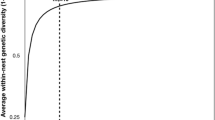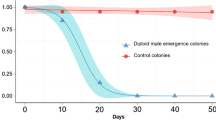Summary
Multiple mating by queens in social Hymenoptera with single locus sex determination may be an adaptation to reduce the effect of genetic load caused by the production of diploid males, if there is a concave relationship between queen fitness and the proportion of diploid male offspring in the colony. In this situation queens should be selected to reduce the variance in the production of diploid male offspring by multiple mating. It has been suggested that this concave relationship occurs in species such as the honey bee, Apis mellifera, in which reproduction occurs near the peak of colony population. This paper suggests that the timing of diploid male removal may influence mating frequency, with early removal of diploid males favoring multiple mating and late removal of diploid males favoring single mating. This idea is explored in two ways. A mathematical model shows that cell use in the brood area of species that rear young in cells will be more efficient with multiple mating. This would favor multiple mating in species, such as the honey bee, in which brood rearing is constrained by the usable area of the brood chamber. Secondly, comparison of polyandrous honey bees (early removal of diploid males as young larvae) with monandrous fire ants, Solenopsis invicta, and Melipona bees (non-removal of immature diploid males) suggests that in the species without diploid male removal, variance reduction may reduce queen fitness. Suggestions are made for testing this hypothesis.
Similar content being viewed by others
References
Adams J, Rothman ED, Kerr WE, Paulino ZL (1977) Estimation of the number of sex alleles and queen matings from diploid male frequencies in a population of Apis mellifera. Genetics 86:583–596
Avitabile A (1978) Brood rearing in honey bee colonies from late autumn to early spring. J Apic Res 17:69–73
Camargo CA de (1979) Sex determination in bees. XI. Production of diploid males and sex determination in Melipona quadrifasciata. J Apic Res 18:77–84
Camargo CA de (1982) Longevity of diploid males, haploid males, and workers of the social bee Melipona quadrifasciata, Hymenoptera, Apidae. J Kans Entomol Soc 55:8–12
Crozier RH (1971) Heterozygosity and sex determination in haplodiploidy. Am Nat 105:399–412
Crozier RH (1977) Evolutionary genetics of the Hymenoptera. Annu Rev Entomol 22:263–288
Crozier RH, Page RE (1985) On being the right size: male contributions and multiple mating in social Hymenoptera. Behav Ecol Sociobiol 18:105–115
Fell RD, Ambrose JT, Burgett DM, DeJong D, Morse RA, Seeley TD (1977) Seasonal cycle of swarming in honey bees (Apis mellifera L.). J Apic Res 16:170–173
Ferracane M (1987) A study of the feasability of obtaining controlled natural-matings of honey bee queens in the Adirondack forest of New York State. Am Bee J 127:845
Gillespie JH (1977) Natural selection for variances in offspring numbers: anew evolutionary principle. Am Nat 111:1010–1014
Jeffree EP (1955) Observations on the decline and growth of honey bee colonies. J Econ Entomol 48:723–726
Kerr WE (1987) Sex determination in bees. XXI. Number of XO heteroalleles in a natural population of Melipona compressipes fasciculata (Apidae). Insectes Soc 34:274–279
Laidlaw HH (1979) Contemporary queen rearing. Dadant, Hamilton
Moritz RFA (1985) The effects of multiple mating on the worker-queen conflict in Apis mellifera. Behav Ecol Sociobiol 16:375–377
Moritz RFA (1986) Sex determination in bees other than Apis. In: Rinderer TE (ed) Honey bee genetics. Academic Press, Orlando, Florida, pp 121–154
Oertel E (1947) In: Root ER (ed) ABC and XYZ of bee culture. AI Root, Medina, pp 204–206
Page RE (1980) The evolution of multiple mating behavior by honey bee queens (Apis mellifera). Genetics 96:263–273
Page RE (1986) Sperm utilization in social insects. Annu Rev Entomol 31:297–320
Page RE, Metcalf RA (1982) Multiple mating, sperm utilization, and social evolution. Am Nat 119:263–281
Ross KG, Fletcher DJC (1985) Genetic origin of male diploidy in the fire ant, Solenopsis invicta (Hymenoptera: Formicidae), and its evolutionary significance. Evolution 39:888–903
Ross KG, Fletcher DJC (1986) Diploid male production — a significant colony mortality factor in the fire ant Solenopsis invicta (Hymenoptera: Formicidae). Behav Ecol Sociobiol 19:283–291
Rubenstein DI (1982) Risk, uncertainty and evolutionary strategies. In: King's College Sociobiology Group (ed) Current problems in sociobiology. Cambridge University Press, Cambridge
Sakagami SF (1982) Stingless bees. In: Hermann HR (ed) Social insects, vol 3. Academic Press, New York, pp 361–423
Seeley TD (1985) Honeybee ecology. Princeton University Press, Princeton
Seeley TD, Visscher PK (1985) Survival of honeybees in cold climates: the critical timing of colony growth and reproduction. Ecol Entomol 10:81–88
Sherman PW, Seeley TD, Reeve HK (1988) Parasites, pathogens, and polyandry in social Hymenoptera. Am Nat 602–610
Wilson EO (1971) The insect societies. Harvard University Press, Cambridge
Winston MR (1987) The biology of the honey bee. Harvard University Press, Cambridge
Woyke J (1963) What happens to diploid drone larvae in a honey bee colony? J Apic Res 2:73–75
Woyke J (1964) Causes of repeated mating flights by queen honeybees. J Apic Res 3:17–23
Woyke J (1980a) Evidence and action of cannibalism substance in Apis cerana indica. J Apic Res 19:6–16
Woyke J (1980b) Effect of sex allele homo-heterozygosity on honeybee colony population and on their honey production. 1. Favorable development conditions. J Apic Res 19:51–63
Woyke J (1981) Effect of sex allele homo-heterozygosity on honeybee colony population and on their honey production. 2. Unfavorable development conditions and restricted queens. J Apic Res 20:148–155
Woyke J (1984) Exploitation of comb cells for brood rearing in honeybee colonies with larvae of different survival rates. Apidologie 15:123–136
Author information
Authors and Affiliations
Rights and permissions
About this article
Cite this article
Ratnieks, F.L.W. The evolution of polyandry by queens in social Hymenoptera: the significance of the timing of removal of diploid males. Behav Ecol Sociobiol 26, 343–348 (1990). https://doi.org/10.1007/BF00171100
Received:
Accepted:
Issue Date:
DOI: https://doi.org/10.1007/BF00171100




